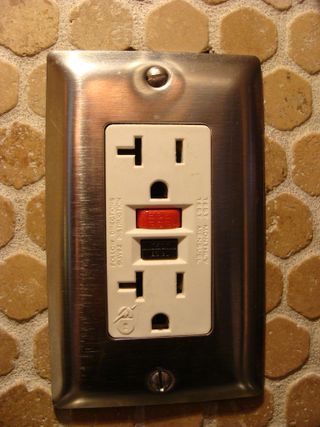For this this week and next week’s blogs, I’ll be waxing on GFCI outlets. I’ll talk about what they do, why they’re so important, what you need to know about them, and how to test the outlets in your own home. 
First, a quick refresher. In my blog about reversed polarity outlets, I explained that there are two wires that conduct current – one gets connected to the earth (grounded) and the other doesn’t. The grounded conductor should always be white, and is referred to as the “neutral” wire. The ungrounded conductor is usually referred to as the “hot” wire, and it can be any color besides white or green, but it’s typically black. Because the neutral wire is connected to the earth, any time you’re in contact with the earth and you touch an ungrounded wire, you’ll complete the circuit and you’ll get a shock. The general, technical name for this event is a ”ground fault”, because current is getting back to the ground in a way that it shouldn’t (it’s using you).
Not all shocks are the same. Here’s where we’ll get in to a little more detail about what happens when a human comes in contact with an ungrounded (hot) conductor.
- No shock. If I could magically levitate and grab on to a ungrounded conductor, I wouldn’t get a shock. I’m not providing a path back to the earth, so the electricity doesn’t have anywhere to go. This is why birds can sit on power lines without getting a shock. No ground fault.
- Small shock. If I were working on the second story of my wood-framed house, wearing rubber soled shoes, standing on the carpet, and then came in contact with an ungrounded conductor, I would probably receive a relatively mild shock. The current has a difficult time traveling through my skin, through my body, through my shoes, through the carpeting, through the wood framing in the house, and eventually back to the earth. I say ‘relatively’ mild because this has happened to me several times, and I’m still here to tell about it. It still hurt like hell every time, and it’s always dangerous. This is a ground fault.
- Severe / lethal shock. If I were holding on to the kitchen faucet with a wet hand and I touched an ungrounded conductor with my other hand, which was also wet, I’d probably get killed. Having a wet hand will make it easier for electricity to pass through my skin. After the electricity passes through my body, it has a very easy time getting back to the earth; it will pass through the kitchen faucet to the water pipes, which are directly connected to my electric panel. This ground fault could easily be enough to kill me.
To prevent lethal shocks through ground faults, special electrical devices called Ground Fault Circuit Interrupters, or GFCIs, are required in homes. If a GFCI device detects a ground fault, it will shut off, or “interrupt” (see what I did there?) current within a fraction of a second. It won’t be fast enough to prevent a painful shock, but it’s enough to keep you from getting killed.
GFCI devices were first required near swimming pools in 1971. Today they’re required in areas where lethal shocks are most likely to happen – typically at areas that are wet and have good contact with the earth. These areas include the exterior, garages, kitchen counter tops, bathrooms, unfinished basements, crawl spaces, and outlets within 6′ of laundry sinks, utility sinks, and wet bar sinks, among other places. For an excellent one-page chart that lists all the locations and shows when the specific requirements went in to effect, click here.
That’s enough information on GFCIs for this week. Next week I’ll talk about the different types of GFCI devices available, the difference between new and old GFCI outlets, how to test them, how they irritate me, and how to save money while installing them.
Reuben Saltzman, Structure Tech Home Inspections –Email–Home Inspector in Minneapolis
